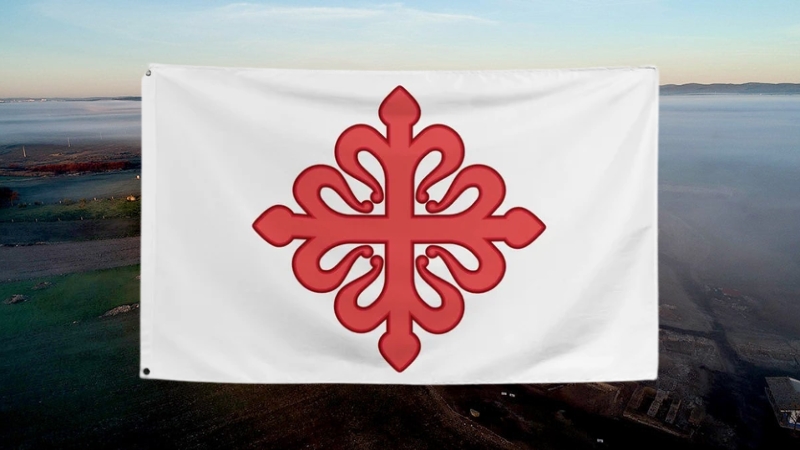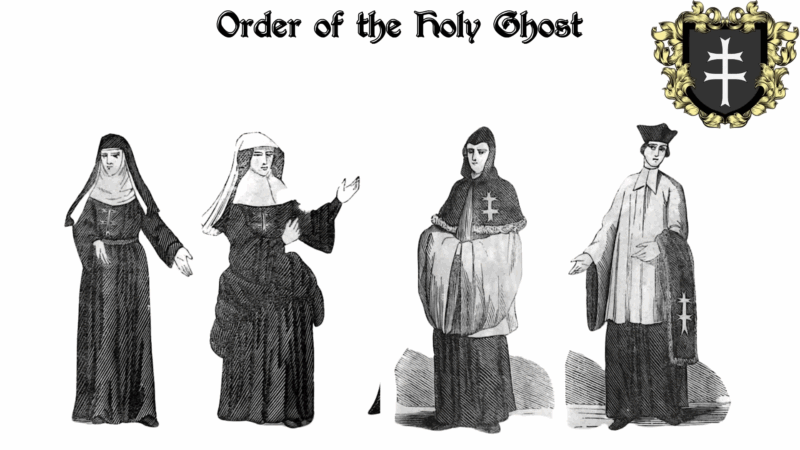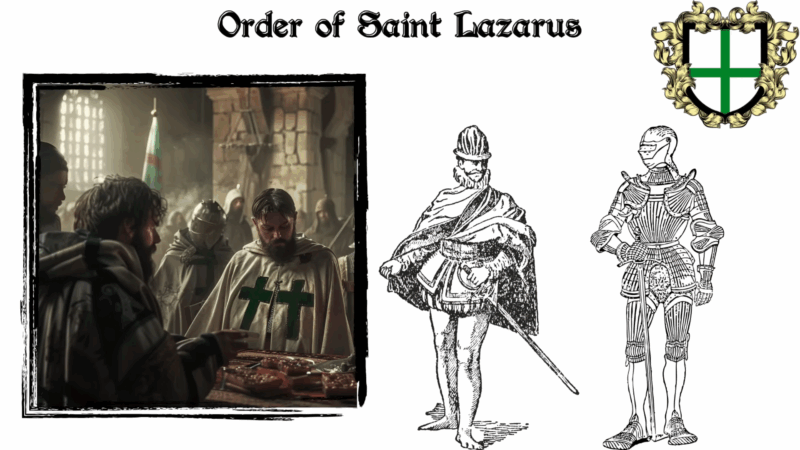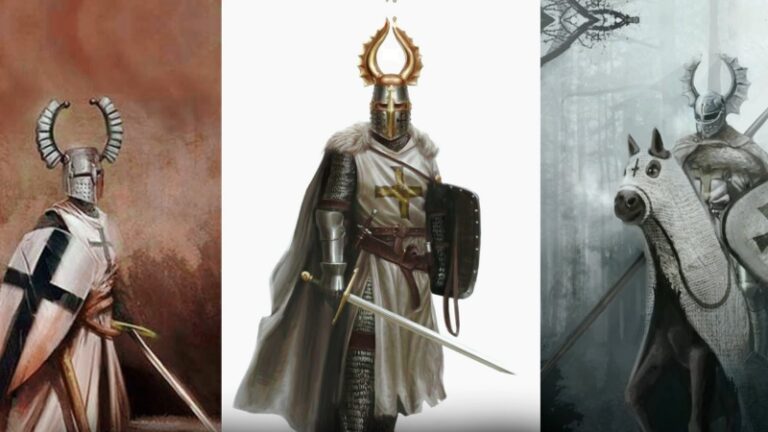When people think of Catholic military orders, they usually recall the legendary Knights Templar or the Hospitallers. Yet these were only the most visible members of a vast and diverse network of religious-military organizations that emerged during the Middle Ages.
Across Europe, especially in the Iberian Peninsula and Eastern Europe, other Catholic orders were established with the explicit purpose of defending Christendom, expanding territorial control, or supporting the Crusades through combat, logistics, and governance.
Many of these lesser-known orders were born out of immediate political and religious needs: to defend frontier towns, reclaim land from Islamic rule, protect pilgrims, or manage wealth seized from dissolved groups like the Templars.
They were often tied directly to royal houses, popes, and monastic communities. These orders combined military discipline with religious devotion, and in many cases, also managed large estates, administered laws, and even conducted diplomacy.
While some faded into history after completing their mission or being absorbed by the crown, others transformed into ceremonial or honorary institutions that continue in symbolic form today.
Regardless of their current status, each of these orders tells a powerful story about how faith, warfare, and governance were intertwined in medieval Europe.
Order of Saint James of the Sword (Portugal)
Feature
Details
Founded
Around 1170
Region
Portugal
Primary Mission
Fight against the Moors during the Reconquista
Patron Saint
St. James the Greater
Distinctive Mark
Red cross in the shape of a sword
Secularized
1789 (officially dissolved 1910)
Modern Legacy
Now, a secular order of merit in Portugal
The Order of Saint James of the Sword (Ordem de Santiago da Espada) was founded around 1170 during the height of the Christian Reconquista in the Iberian Peninsula. Originally a branch of the Spanish Order of Santiago, its Portuguese wing soon established itself as a distinct entity under the Portuguese crown.
Its primary goal was to combat the Muslim forces occupying southern Portugal, particularly in the Alentejo and Algarve regions. The order took its name from Saint James the Greater, who had become a military symbol and rallying figure for Christian forces during the Reconquista.
View this post on Instagram
The knights lived by the Rule of St. Augustine and were both monks and warriors. They also swore vows of chastity, obedience, and poverty. They received extensive land grants, including castles and frontier territories, which they defended and administered. Their most significant base was in Palmela, which they fortified into a massive stronghold.
By the 14th and 15th centuries, the Order played a key role in Portugal’s expansion into North Africa and supported the country’s growing maritime ventures. Several knights served aboard ships in Portugal’s overseas expeditions.
In the 16th century, the order’s religious character began to erode. In 1551, Pope Julius III gave the Portuguese king the right to appoint the Grand Master, and in 1789, it was secularized and converted into an honorary order of merit. It was dissolved with the establishment of the Portuguese Republic in 1910, but later revived in ceremonial form.
Order of Calatrava
Feature
Details
Founded
1158
Region
Castile (Spain)
Religious Rule
Cistercian Rule
First Grand Master
Don García
Monastic Center
Monastery of Calatrava
Military Role
Defended frontier towns against Muslims
Founded in 1158, the Order of Calatrava is one of the earliest military orders in Spain, created specifically to defend the fortress town of Calatrava la Vieja, on the edge of Muslim-held territory.
The town had been handed over to Cistercian monks by King Sancho III of Castile, but when it became apparent they could not defend it, a warrior-monk named Raymond of Fitero organized a group of knights under monastic rule.
The knights took vows similar to those of Cistercian monks but committed themselves to warfare against the Moors. They wore white mantles with a distinctive red cross (later fleur-de-lis styled), symbolizing their martial and religious identity.

Over the next centuries, the Order of Calatrava played a crucial role in major campaigns such as the Battle of Las Navas de Tolosa in 1212, a decisive Christian victory that shifted the momentum of the Reconquista. The order expanded its territories and amassed considerable political and economic power, with castles, estates, and even towns under its control.
However, in the late Middle Ages, internal disputes, secular ambition, and royal intervention weakened the order. In 1487, Ferdinand the Catholic became the administrator of the order, and in 1523, the Grand Mastership was permanently united with the Spanish crown by Pope Adrian VI.
Order of Alcántara
Feature
Details
Founded
Late 12th century
Region
Extremadura, Spain
Religious Rule
Initially Benedictine, later Cistercian
Headquarters
Alcántara
Monarch Control
Crown took control in 1494
The Order of Alcántara originated in the late 12th century in the Kingdom of León, founded as a brotherhood of knights to defend Christian lands along the volatile frontier with Islamic territories. Initially named the Order of San Julián del Pereiro, it was given the town of Alcántara, on the Tagus River, after a series of successful campaigns.
Similar to other Iberian orders, the knights of Alcántara took monastic vows under the Rule of St. Benedict, though they later adopted the Cistercian discipline. Their primary role was to defend border areas from Moorish raids and fortify the Christian presence in newly reclaimed lands.
The order was known for its strict military discipline and its control over vast tracts of land, especially in Extremadura.
However, like other military orders, it was not immune to internal rivalry and corruption. The order often became embroiled in dynastic disputes and power struggles, particularly during the 14th and 15th centuries.
In 1494, King Ferdinand of Aragon obtained control of the order through a papal bull. From that point forward, the order became a royal appendage and lost much of its autonomy. Though it continued as a noble order with social prestige, its military and religious roles faded into history.
Order of Montesa
Feature
Details
Founded
1317
Region
Kingdom of Aragon
Purpose
Absorb Templar properties after their fall
Headquarters
Montesa Monastery
Monarch Control
Unified with the Spanish crown in 1587
The Order of Montesa was created in 1317 by King James II of Aragon after the dissolution of the Knights Templar. Eager to prevent Templar wealth from falling into foreign hands, James negotiated with Pope John XXII to establish a new order based on the Templar model.
Montesa was located in the Kingdom of Valencia, and the order was charged with defending the coast against pirates and Muslim incursions. It was placed under the spiritual guidance of the Cistercian Order, like Calatrava and Alcántara.
Sword of the Military Order of Montesa.https://t.co/SLkU5F5BpV. ENCYCLOPEDIA OF SPANISH SWORDS CEÑIR SWORD. Author: Vicente Toledo Momparler (sword expert) Reference 3-oamo-A Name Ceñir Sword Order Military Order of Montes pic.twitter.com/55Ir16TYYS
— Medieval-Shop (@Medieval_Shop) April 20, 2025
Though not as militarily active as other Iberian orders, Montesa gained wealth and influence through land grants and noble patronage. It inherited many of the Templars’ properties in the Crown of Aragon.
Over time, the order’s military functions declined. In 1587, the Grand Mastership was united with the Spanish monarchy. Montesa survived as a symbolic institution and still exists in a ceremonial capacity today, associated with the Spanish nobility.
Order of the Holy Ghost (Santo Spirito)
Feature
Details
Founded
c. 1170s (France/Italy)
Founder
Guy de Montpellier
Focus
Care for the poor and sick
Military Role
Minimal; supported Crusader efforts indirectly
Modern Status
Eventually dissolved
Founded around 1170 by Guy de Montpellier, the Order of the Holy Ghost was a unique blend of religious and medical ideals. It was not primarily a military order, but due to its support of Crusader forces through hospitals and humanitarian efforts, it is often included in the broader family of knightly orders.
The order specialized in caring for the sick, orphans, and poor. They built hospitals across Europe and the Holy Land, with their central headquarters in Rome, near the Vatican, known as the Hospital of Santo Spirito in Sassia.

Members were called “Brothers of the Holy Ghost,” and some of them served with Crusader armies in a non-combat role, ensuring that wounded soldiers and pilgrims received care.
Although they were never warriors, their logistical and charitable support was essential to the Crusader infrastructure. The order began to decline in influence during the Renaissance but inspired the foundation of other religious hospitals in later centuries.
Order of Saint Lazarus
Feature
Details
Founded
Early 12th century
Primary Base
Jerusalem
Focus
Care of lepers
Military Role
Defended the Crusader states
Unique Element
Many members were lepers themselves
The Order of Saint Lazarus began as a leper hospital outside the walls of Jerusalem during the early 12th century. Originally intended to serve knights and pilgrims afflicted with leprosy, the order gradually took on a military function.
By the mid-12th century, the Lazarite knights, many of whom were lepers themselves, were fighting alongside the Templars and Hospitallers in defense of the Crusader states.

After the fall of Jerusalem, the order established itself in Acre and later relocated to France and Italy. They retained control of several hospitals and commanderies, and became particularly influential in France, where they often merged with local hospitaller institutions.
In 1572, the French branch merged with the Order of Our Lady of Mount Carmel, creating a hybrid noble order under royal patronage. The modern Order of Saint Lazarus claims descent from these traditions, though it is more ceremonial and charitable today.
Order of the Dragon
Feature
Details
Founded
1408
Region
Kingdom of Hungary
Founders
King Sigismund of Luxembourg & Queen Barbara
Main Enemies
Ottomans, heretics
Famous Members
Vlad II Dracul, Despot Stefan Lazarević
Symbol
Green dragon eating its tail, red cross
Founded in 1408 by King Sigismund of Luxembourg (later Holy Roman Emperor), the Order of the Dragon was not monastic, but it was deeply aligned with the Catholic Church and functioned as a knightly brotherhood devoted to defending Christendom.
It was primarily a political and military order intended to unify Christian nobility against the Ottoman Empire and internal heresies like the Hussites. Its members wore a dragon insignia, eating its tail (symbolizing eternity), with a red cross across its back.
One of its most celebrated members was Despot Stefan Lazarević of Serbia, a warrior-scholar-prince known for his reforms, bravery, and cultural sophistication. Another key figure was Vlad II Dracul, father of Vlad the Impaler (Dracula), who took the dragon symbol as part of his name.
The order was short-lived in institutional terms but left a significant mark in Eastern European heraldry, noble society, and the Dracula mythos. Its fusion of religion, politics, and warfare captured the spirit of a Europe under threat.
Bottom Line
These Catholic military orders, though less famous, were pivotal in shaping medieval Christendom. Each played a unique role—from defending Iberian borders and caring for the sick to resisting Ottoman invasions and inspiring dynastic legends.
The Swiss Guard, which traces its origins to these military traditions, continues to serve as the papal guard to this day, embodying centuries of devotion and military service.
Their legacies endure in ceremonial institutions, noble titles, and the historical memory of a turbulent era of faith and warfare.

